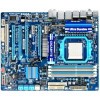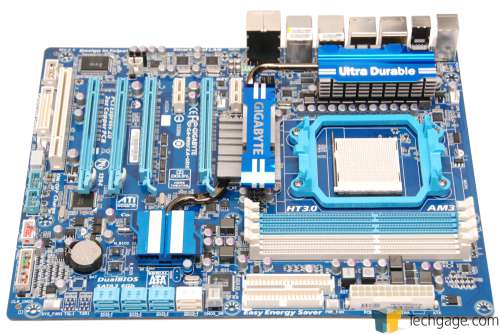- Qualcomm Launches Snapdragon 4 Gen 2 Mobile Platform
- AMD Launches Ryzen PRO 7000 Series Mobile & Desktop Platform
- Intel Launches Sleek Single-Slot Arc Pro A60 Workstation Graphics Card
- NVIDIA Announces Latest Ada Lovelace Additions: GeForce RTX 4060 Ti & RTX 4060
- Maxon Redshift With AMD Radeon GPU Rendering Support Now Available
Gigabyte 890FXA-UD5

In the market for a dual-GPU capable AMD motherboard, and one that’s capable of achieving some huge overclocks? Gigabyte has you covered, with its 890FXA-UD5. In addition to having native SATA 3.0 support, USB 3.0 support can also be found, along with 4 PCI-E x16 graphics slots, a near-perfect board design and good pricing.
Page 10 – Power Consumption, Final Thoughts
It goes without saying that power efficiency is at the forefront of many consumers’ minds today, and for good reason. Whether you are trying to save money or the environment – or both – it’s good to know just how much effort certain vendors are putting into their products to help them excel in this area. Both AMD and Intel have worked hard to develop efficient chips, and that’s evident with each new launch. The CPUs are getting faster, and use less power, and hopefully things will stay that way.
To help see what kind of wattage a given configuration draws on average, we use a Kill-A-Watt that’s plugged into a power bar that’s in turn plugged into one of the wall sockets, with the test system plugged directly into that. The monitor and other components are plugged into the other socket and is not connected to the Kill-A-Watt. For our system specifications, please refer to our methodology page.
To test, the computer is first boot up and left to sit at idle for five minutes, at which point the current wattage is recorded if stable. To test for full CPU load, LinX is run with 6144MB memory usage for a total of eight – ten minutes. During that run, the highest point the wattage reaches on the meter is captured and becomes our “Max Load”.

The feature-sets on these two boards are mostly the same, but the 890FXA-UD5 ups the ante with SATA 6Gbit/s and USB 3.0, so the minor hike in power consumption seems warranted.
Final Thoughts
Although this was the first 890FX board I really had the opportunity to spend a lot of time benchmarking the heck out of, I come out of testing impressed, although that in itself isn’t too surprising. As a whole, the 890FXA-UD5 reminds me a lot of the 790FXT-UD5P, and for the most part, it’s primarily because the differences lay with the chipset and SATA/USB 3.0… there’s not too much different.
The 890FXA-UD5 offers a huge amount of functionality, from the 4x PCI-E x16 slots to the 5 fan ports scattered about. The addition of SATA and USB 3.0 make the entire deal that much sweeter, but as time goes on, those features are becoming less of a luxury and more of a common occurrence. The whole package here is good, though, with nary a major complaint from me.
Price-wise, this board falls in at around $180, which puts it in line with other mainstream 890FX boards of its feature-set. There are some 890FX boards that cost less, but some features are of course sacrificed, and really, it’s up to you to decide if they are worthy of being sacrificed or not. If you don’t particularly care for the dual-GPU x16 capability, for example, you could always back down to 890GX boards. Even Gigabyte’s own 890GPA-UD3H looks quite good and full-featured, and retails for just $140. It does offer less features as whole though, but nothing important as I can see.
If in the market for an 890FX board, you won’t go wrong with this one. I still can’t speak too much on overclocking though, until I have some basis for comparison. I’m leaning towards the fact that our 1090T just isn’t that great of an overclocker, but until I benchmark it with another 890XX board, I won’t be able to say for certain.
Discuss this article in our forums!
Have a comment you wish to make on this article? Recommendations? Criticism? Feel free to head over to our related thread and put your words to our virtual paper There is no requirement to register in order to respond to these threads, but it sure doesn’t hurt!
Support our efforts! With ad revenue at an all-time low for written websites, we're relying more than ever on reader support to help us continue putting so much effort into this type of content. You can support us by becoming a Patron, or by using our Amazon shopping affiliate links listed through our articles. Thanks for your support!






